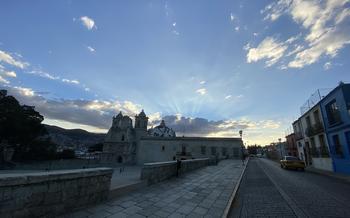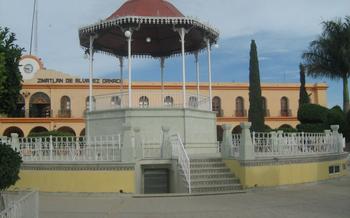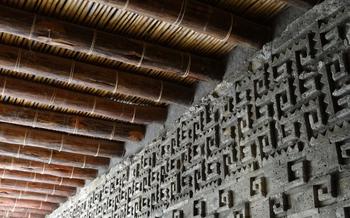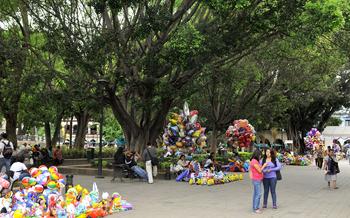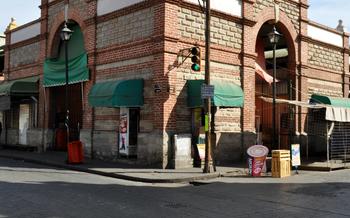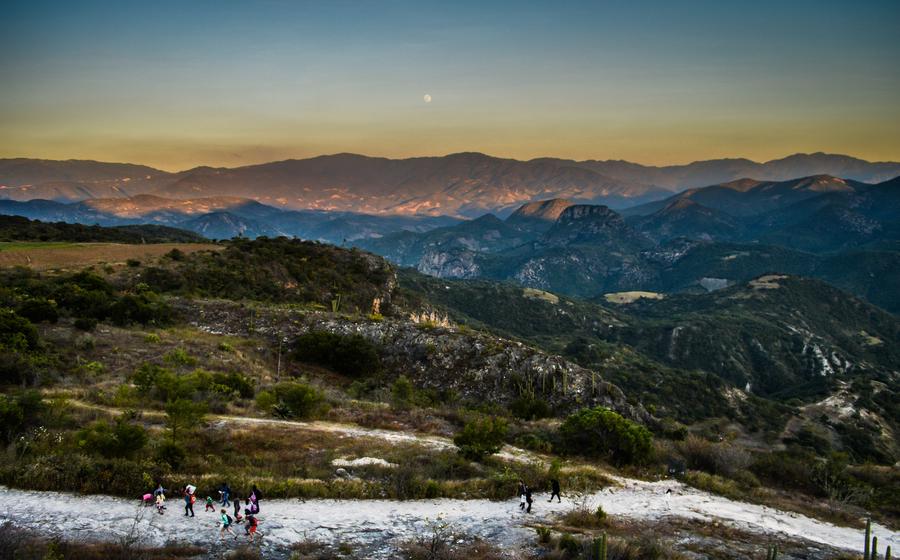
Hierve el Agua
- Hierve el Agua: A Natural Wonder in Oaxaca
- Getting There: Transportation Options
- Public Transportation: A Budget-Friendly Choice
- Guided Tours: A Hassle-Free Experience
- Private Transportation: Flexibility and Convenience
- Admission Fees and Operating Hours
- Hiking Trails and Exploration
- Swimming in the Natural Pools
- Camping and Accommodation Options
- Food and Beverages: What to Bring
- Guided Tours vs. Independent Exploration
- Safety and Precautions
Hierve el Agua: A Natural Wonder in Oaxaca
In the heart of the Sierra Madre Mountains, nestled in the enchanting state of Oaxaca, lies a natural wonder that defies description - Hierve el Agua. This breathtaking geological formation features a series of cascading, petrified waterfalls that flow over the edge of a cliff, creating a mesmerizing spectacle that seems to defy gravity. Formed by centuries of mineral-rich spring water flowing over the cliff's edge, these unique travertine formations have sculpted intricate terraces and pools, inviting visitors to immerse themselves in their surreal beauty.
Hierve el Agua holds a special place in the hearts of the local Zapotec people, who have woven legends and stories around its existence. According to one legend, the waterfalls were created by a heartbroken goddess who shed tears that turned into stone, forever cascading over the cliff in her eternal sorrow. The site's cultural significance is further enhanced by the nearby pre-Hispanic Zapotec ruins, adding a layer of historical intrigue to this natural masterpiece.
As you stand on the edge of the cliff, gazing out over the panoramic vistas that stretch for miles, you'll feel an overwhelming sense of awe and wonder. The stunning views encompass rolling hills, lush vegetation, and distant mountain ranges, creating a breathtaking backdrop for this natural phenomenon. Hierve el Agua stands as a testament to the power and beauty of nature, a reminder of the hidden gems that await those willing to venture off the beaten path and explore the wonders that our planet holds.
Getting There: Transportation Options
Public Transportation: A Budget-Friendly Choice
For a cost-effective option, consider taking public transportation from Oaxaca City to Hierve el Agua. Several local buses depart from the main bus station (Central de Autobuses) daily, offering a comfortable and affordable journey. The trip takes approximately 5 hours, and the buses provide a scenic route through the picturesque Oaxacan countryside. Remember to inquire about the bus schedule and fares in advance to plan your trip accordingly.
Guided Tours: A Hassle-Free Experience
If you prefer a hassle-free experience, booking a guided tour from Oaxaca City is a great choice. Numerous tour operators offer day trips to Hierve el Agua, typically including transportation, a knowledgeable guide, and entrance fees. The guided tours provide valuable insights into the history, geology, and cultural significance of the site, enhancing your overall experience. When selecting a tour operator, research their reputation, read reviews, and compare prices to find the best fit for your needs and budget.
Private Transportation: Flexibility and Convenience
For those seeking flexibility and convenience, renting a car is an excellent option to reach Hierve el Agua. Several car rental agencies are available in Oaxaca City, offering a range of vehicles to suit your preferences and budget. The drive from Oaxaca City to Hierve el Agua takes approximately 5 hours, and the roads are generally well-maintained. Enjoy the scenic journey through the Oaxacan landscapes and make spontaneous stops along the way to explore hidden gems or savor local delicacies. Remember to factor in fuel costs and parking fees when considering this option.
Admission Fees and Operating Hours
To visit Hierve el Agua, an entrance fee is required. The regular admission fee is [specify amount], while students, seniors, and children can benefit from discounted rates. It's advisable to carry a valid ID to avail of these discounts.
The natural wonder is open to the public daily from [specify opening hours] to [specify closing hours]. However, it's recommended to plan your visit during the early morning or late afternoon to avoid the midday heat and crowds. During these times, you'll have a more serene and enjoyable experience, allowing you to fully appreciate the beauty of Hierve el Agua.
If you're planning a day trip from Oaxaca City, it's feasible to visit Hierve el Agua and return on the same day. However, if you wish to immerse yourself fully in the natural beauty and tranquility of the site, consider staying overnight in one of the nearby hotels or guesthouses. This will give you ample time to explore the hiking trails, swim in the natural pools, and take in the breathtaking views at your own pace.
Hiking Trails and Exploration
Hierve el Agua offers a network of well-maintained hiking trails that allow visitors to explore the natural wonders of the site. These trails range in difficulty from easy to moderate, making them suitable for hikers of all levels. The trails wind through the petrified waterfalls, rock formations, and dense vegetation, providing breathtaking views of the surrounding landscape.
One of the most popular trails is the Cascadas Petrificadas Trail, which takes hikers past the impressive petrified waterfalls. These waterfalls were formed by the deposition of minerals from the water, creating a unique and stunning sight. The trail also offers panoramic views of the valley below.
Another must-do trail is the Sendero Mirador Trail, which leads to a viewpoint overlooking the entire site. From this vantage point, visitors can marvel at the vastness of Hierve el Agua and the surrounding mountains.
When hiking at Hierve el Agua, it is important to wear comfortable shoes and clothing, as the terrain can be uneven and slippery. It is also advisable to bring water and snacks, as there are no food or beverage options available on the trails.
Swimming in the Natural Pools
Hierve el Agua's natural pools are a refreshing oasis amidst the stunning rock formations. These crystal-clear pools, fed by natural springs, invite visitors to take a dip and cool off from the warm Mexican sun. The water temperature is pleasantly warm, hovering around 25 degrees Celsius (77 degrees Fahrenheit), making it ideal for swimming and relaxation.
For the best swimming experience, aim to visit during the early morning or late afternoon when the sun is less intense. Remember to bring your swimsuit, towel, and a change of clothes. The pools are suitable for swimmers of all levels, but it's essential to exercise caution and avoid diving or jumping from the rocks.
Respecting the environment is crucial when swimming in these natural pools. Avoid using harsh chemicals or soaps that could harm the delicate ecosystem. Additionally, refrain from disturbing the wildlife, as the pools are home to various aquatic creatures.
Pack a picnic lunch and enjoy a meal surrounded by the breathtaking scenery. Remember to dispose of your waste responsibly, leaving no trace behind to preserve the pristine beauty of this natural wonder.
Camping and Accommodation Options
Hierve el Agua offers a unique opportunity to immerse yourself in nature by camping under the stars. Designated campsites are available, providing a rustic yet comfortable experience. These sites come equipped with basic amenities, including restrooms and showers. For those seeking a more luxurious stay, nearby hotels and guesthouses offer a range of options, from cozy bed and breakfasts to upscale resorts. It's advisable to book accommodation in advance, especially during peak season, to avoid disappointment. While in the area, take advantage of the chance to explore other nearby attractions, such as the Mitla ruins or the Tule Tree, which boasts the widest trunk of any tree in the world.
Food and Beverages: What to Bring
When visiting Hierve el Agua, it's essential to come prepared with food and beverages, as limited options are available on-site. Packing a picnic lunch or snacks is recommended to enjoy a leisurely meal amidst the stunning natural scenery. Local specialties like tlayudas (Oaxacan pizza) or chapulines (grasshoppers) can be purchased from vendors in nearby towns and make for a delicious and authentic culinary experience. Staying hydrated is crucial in the warm climate, so bringing reusable water bottles is advisable to minimize waste and support sustainability efforts. A refreshing dip in the natural pools can be even more enjoyable with a cold beverage or snack, making it a memorable and refreshing experience.
Guided Tours vs. Independent Exploration
Whether to embark on a guided tour or explore Hierve el Agua independently is a personal choice that depends on your preferences, budget, and time constraints. Each option offers unique advantages and drawbacks.
Guided Tours:
-
Pros:
- Knowledgeable guides provide historical and geological insights.
- Convenient transportation to and from the site.
- Organized itinerary ensures you see all the highlights.
- Opportunity to socialize with fellow travelers.
-
Cons:
- Can be more expensive than independent exploration.
- Less flexibility to explore at your own pace.
- May not be able to customize the tour to your interests.
Independent Exploration:
-
Pros:
- More flexibility to explore at your own pace.
- Can customize your itinerary based on your interests.
- More opportunities for solitude and connection with nature.
- Can save money by avoiding tour fees.
-
Cons:
- Requires more research and planning.
- Need to arrange your own transportation.
- May miss out on valuable insights from a guide.
Ultimately, the best choice depends on your individual preferences. If you value convenience, historical context, and a structured experience, a guided tour may be a good option. If you prefer the freedom to explore at your own pace, save money, and have a more personal experience, independent exploration may be a better fit.
Safety and Precautions
Visiting Hierve el Agua is generally safe, but it's essential to take precautions to ensure a smooth and enjoyable experience. The terrain can be uneven and slippery, especially after rain, so wearing sturdy and comfortable shoes is crucial. Proper clothing is recommended, considering the warm climate and the possibility of encountering insects or vegetation. Respecting the natural environment is paramount, and visitors should avoid disturbing the wildlife or damaging the delicate rock formations. Staying hydrated is essential, especially in the warm and dry climate. Protecting against the sun with sunscreen, sunglasses, and a hat is also recommended. Be prepared for changes in weather conditions, as sudden storms or changes in temperature can occur. It's advisable to inform someone about your travel plans and expected return time, especially if exploring independently.

